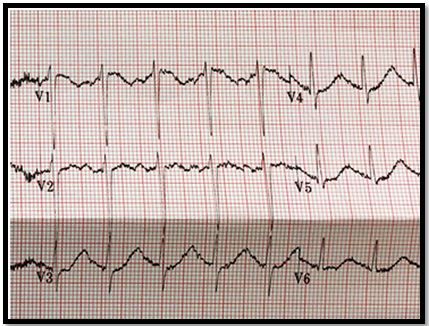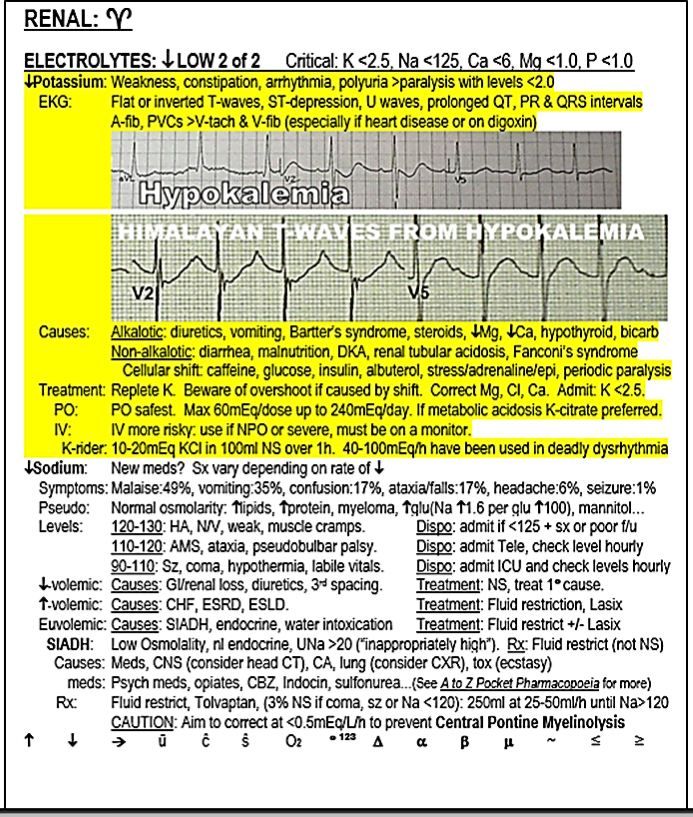- Clinical Technology
- Adult Immunization
- Hepatology
- Pediatric Immunization
- Screening
- Psychiatry
- Allergy
- Women's Health
- Cardiology
- Pediatrics
- Dermatology
- Endocrinology
- Pain Management
- Gastroenterology
- Infectious Disease
- Obesity Medicine
- Rheumatology
- Nephrology
- Neurology
- Pulmonology
ECG Challenge: Palpitations and Diarrhea in a Young Woman
Physical exam, including vitals, is normal although patient is tremulous. Blood sent for labs, so look for clues in the ECG.
Figure 1. (Please click to enlarge)

Figure 2. (Please click to enlarge)

History: A 39-year-old woman presents to the emergency department complaining of palpitations. She says she has also had "a little diarrhea" today, but that she has similar symptoms any time she is stressed. She denies any fever, abdominal pain, chest pain, syncope, or near-syncope. She also denies any relevant medical history but says she does take furosemide as needed when her legs swell. She states that her regular doctor ordered a full blood panel and an echocardiogram to look for a cause of the swelling and that everything was fine.
Examination: Her exam is essentially normal including her vital signs. There are no rales and no peripheral edema. She does, however, seem a bit shaky/tremulous.
Initial concerns: Dysrhythmia, electrolyte abnormality
Testing: Her ECG is shown in Figure 1, at top right (click on image to enlarge).
Questions:
- What are the ECG findings?
- What is the most likely diagnosis?
- What is the most likely cause?
For answers and discussion, please click below.
Answers1. What are the ECG findings? Long QTc of 550 ms, as well as tachycardia at a rate of around 125 beats/min. It is difficult to tell if the rhythm is sinus or not.
2. What is the most likely diagnosis? Hypokalemia from diarrhea and/or Lasix; potassium was critically low at 1.8 mEq/L (magnesium was normal at 1.8 mg/dL). Bicarboante was high at 48 mEq/L (consistent with a contraction alkalosis, likely from the diuretic).
3. What is the most likely cause? Diuretic abuse. Other causes of hypokalemia are noted in the highlighted area of page-shot in Figure 2 at right (click on image to enlarge).
Discussion
Hypokalemia often is asymptomatic but may cause generalized weakness, constipation, and polyuria as well as cardiac dysrhythmias that, in turn, lead to palpitations or near-syncope. When potassium levels drop below 2 mEq/L muscle paralysis may occur. ECG changes may occur before overt symptoms and usually include flat and/or inverted T-wave, ST-depression, U-waves, and prolongation of the QT, PR, and QRS intervals in more severe cases. Atrial and ventricular dysrhythmias also may occur.
There are many types of hypokalemia and they can be categorized into alkalotic and non-alkalotic causes (see highlighted part of page shot in Figure 2 at right). If you look at the list in the Figure you will notice that diarrhea causes non-alkalotic hypokalemia, but diuretics cause alkalotic hypokalemia. Since the patient’s bicarbonate level was extremely high (48 mEq/L), the furosemide is the most likely culprit in this case.
Treatment of hypokalemia naturally begins with potassium administration: oral repletion is generally considered safest, with IV repletion reserved for unstable patients or those with levels less than 2.5 mEq/L. In cases where hypokalemia is caused by cellular shift, be careful not to overtreat as rebound hyperkalemia is a risk when the shift is reversed. It is also, of course, important to reverse, remove, or treat any causative factors, such as medication in this case (refer to highlighted part of page-shot in Figure 2 above, for more info).
